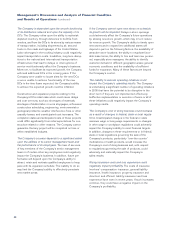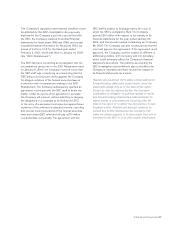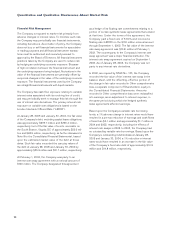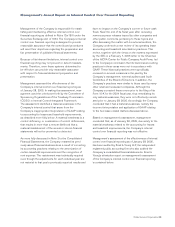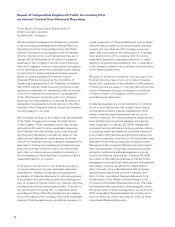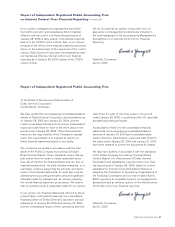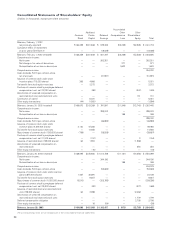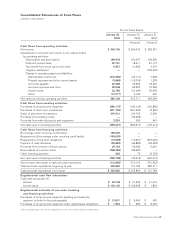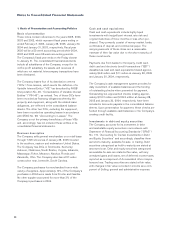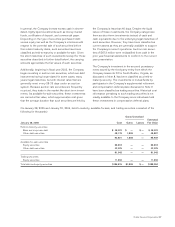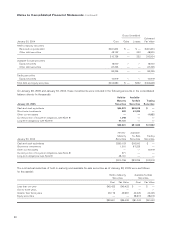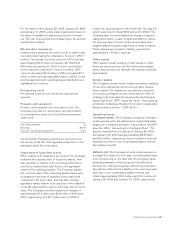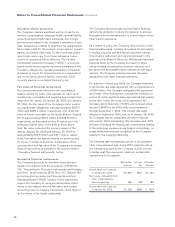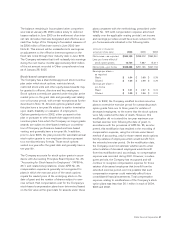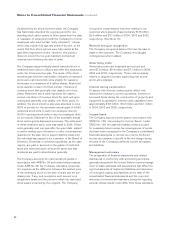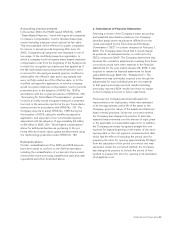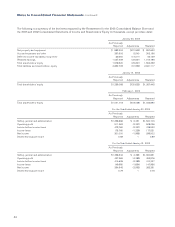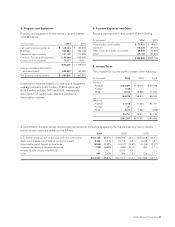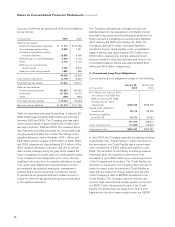Dollar General 2004 Annual Report Download - page 38
Download and view the complete annual report
Please find page 38 of the 2004 Dollar General annual report below. You can navigate through the pages in the report by either clicking on the pages listed below, or by using the keyword search tool below to find specific information within the annual report.36
Notes to Consolidated Financial Statements
1. Basis of Presentation and Accounting Policies
Basis of presentation
These notes contain references to the years 2005, 2004,
2003 and 2002, which represent fiscal years ending or
ended February 3, 2006, January 28, 2005, January 30,
2004 and January 31, 2003, respectively. Fiscal year
2005 will be a 53-week accounting period while 2004,
2003 and 2002 were 52-week accounting periods.
The Company’s fiscal year ends on the Friday closest
to January 31. The consolidated financial statements
include all subsidiaries of the Company, except for its
not-for-profit subsidiary the assets and revenues of
which are not material. Intercompany transactions have
been eliminated.
The Company leases four of its distribution centers
(“DCs”) from lessors, which meets the definition of a
Variable Interest Entity (“VIE”) as described by FASB
Interpretation No. 46, “Consolidation of Variable Interest
Entities” (“FIN 46”), as revised. Two of these DCs have
been recorded as financing obligations whereby the
property and equipment, along with the related lease
obligations, are reflected in the consolidated balance
sheets. The other two DCs, excluding the equipment,
have been recorded as operating leases in accordance
with SFAS No. 98, “Accounting for Leases.” The
Company is not the primary beneficiary of these VIEs
and, accordingly, has not included these entities in its
consolidated financial statements.
Business description
The Company sells general merchandise on a retail basis
through 7,320 stores (as of January 28, 2005) located
in the southern, eastern and midwestern United States.
The Company has DCs in Scottsville, Kentucky;
Ardmore, Oklahoma; South Boston, Virginia; Indianola,
Mississippi; Fulton, Missouri; Alachua, Florida; and
Zanesville, Ohio. The Company also has a DC under
construction near Jonesville, South Carolina.
The Company purchases its merchandise from a wide
variety of suppliers. Approximately 10% of the Company’s
purchases in 2004 were made from Procter and Gamble.
No other supplier accounted for more than 3% of the
Company’s purchases in 2004.
Cash and cash equivalents
Cash and cash equivalents include highly liquid
investments with insignificant interest rate risk and
original maturities of three months or less when pur-
chased. They primarily consist of money market funds,
certificates of deposit and commercial paper. The
carrying amounts of these items are a reasonable
estimate of their fair value due to the short maturity of
these investments.
Payments due from banks for third-party credit card,
debit card and electronic benefit transactions (“EBT”)
classified as cash and cash equivalents totaled approxi-
mately $4.8 million and $1.1 million at January 28, 2005
and January 30, 2004, respectively.
The Company’s cash management system provides for
daily investment of available balances and the funding
of outstanding checks when presented for payment.
Outstanding but unpresented checks totaling approxi-
mately $112.3 million and $105.2 million at January 28,
2005 and January 30, 2004, respectively, have been
included in Accounts payable in the consolidated balance
sheets. Upon presentation for payment, these checks are
funded through available cash balances or the Company’s
existing credit facility.
Investments in debt and equity securities
The Company accounts for its investment in debt
and marketable equity securities in accordance with
Statement of Financial Accounting Standards (“SFAS”)
No. 115, “Accounting for Certain Investments in Debt
and Equity Securities” and accordingly, classifies them
as held-to-maturity, available-for-sale, or trading. Debt
securities categorized as held-to-maturity are stated at
amortized cost. Debt and equity securities categorized
as available-for-sale are stated at fair value, with any
unrealized gains and losses, net of deferred income taxes,
reported as a component of Accumulated other compre-
hensive loss. Trading securities are stated at fair value,
with changes in fair value recorded in income as a com-
ponent of Selling, general and administrative expense.


